BMP3002 Business in Practice: Types and Factors Report
VerifiedAdded on 2023/01/05
|9
|2894
|79
Report
AI Summary
This report, prepared for the BMP3002 Business in Practice module, provides a detailed analysis of various business types and structures. It begins by defining and differentiating between micro, small, medium, and large businesses, highlighting their characteristics and operational aspects. The report then examines different company structures, including sole traders, partnerships, limited liability partnerships, and cooperatives, detailing their features and implications. Furthermore, it delves into the impact of organizational structures, such as functional, divisional, flat, and network structures, on business productivity. Finally, the report explores the influence of external factors on business performance, utilizing the PESTEL framework to analyze political, economic, social, technological, environmental, and legal factors. The report aims to provide a comprehensive understanding of the business landscape and the factors that shape business success.
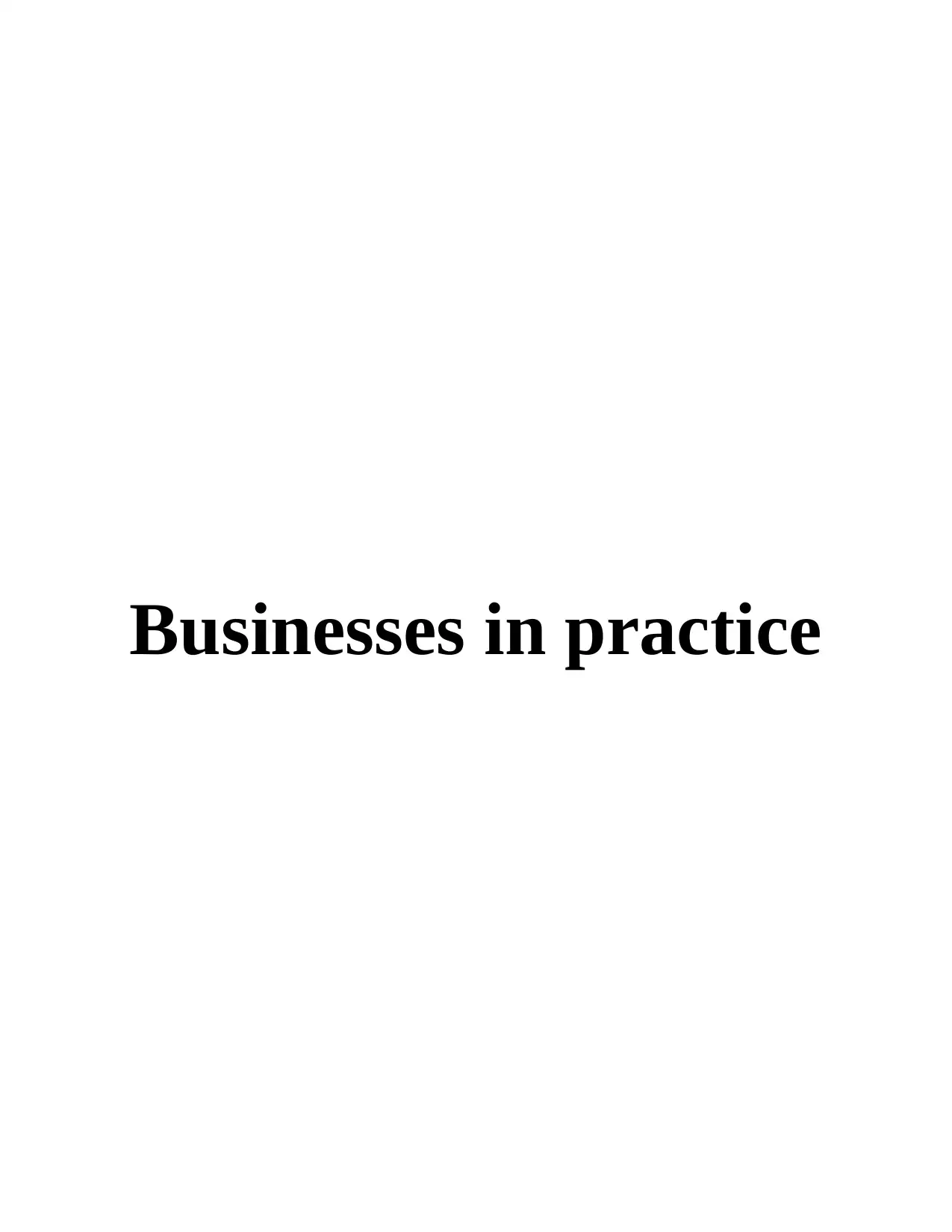
Businesses in practice
Paraphrase This Document
Need a fresh take? Get an instant paraphrase of this document with our AI Paraphraser
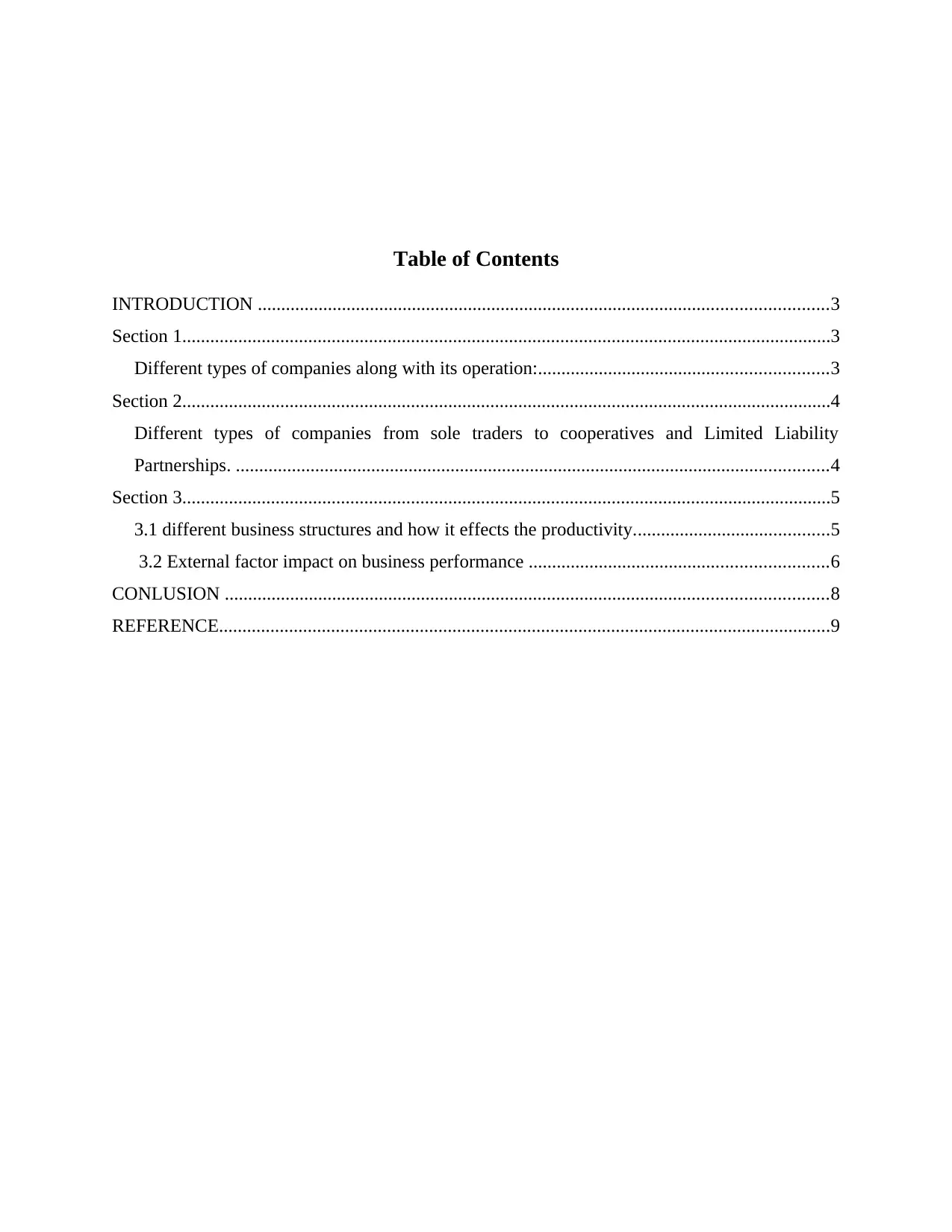
Table of Contents
INTRODUCTION ..........................................................................................................................3
Section 1...........................................................................................................................................3
Different types of companies along with its operation:..............................................................3
Section 2...........................................................................................................................................4
Different types of companies from sole traders to cooperatives and Limited Liability
Partnerships. ...............................................................................................................................4
Section 3...........................................................................................................................................5
3.1 different business structures and how it effects the productivity..........................................5
3.2 External factor impact on business performance ................................................................6
CONLUSION .................................................................................................................................8
REFERENCE...................................................................................................................................9
INTRODUCTION ..........................................................................................................................3
Section 1...........................................................................................................................................3
Different types of companies along with its operation:..............................................................3
Section 2...........................................................................................................................................4
Different types of companies from sole traders to cooperatives and Limited Liability
Partnerships. ...............................................................................................................................4
Section 3...........................................................................................................................................5
3.1 different business structures and how it effects the productivity..........................................5
3.2 External factor impact on business performance ................................................................6
CONLUSION .................................................................................................................................8
REFERENCE...................................................................................................................................9
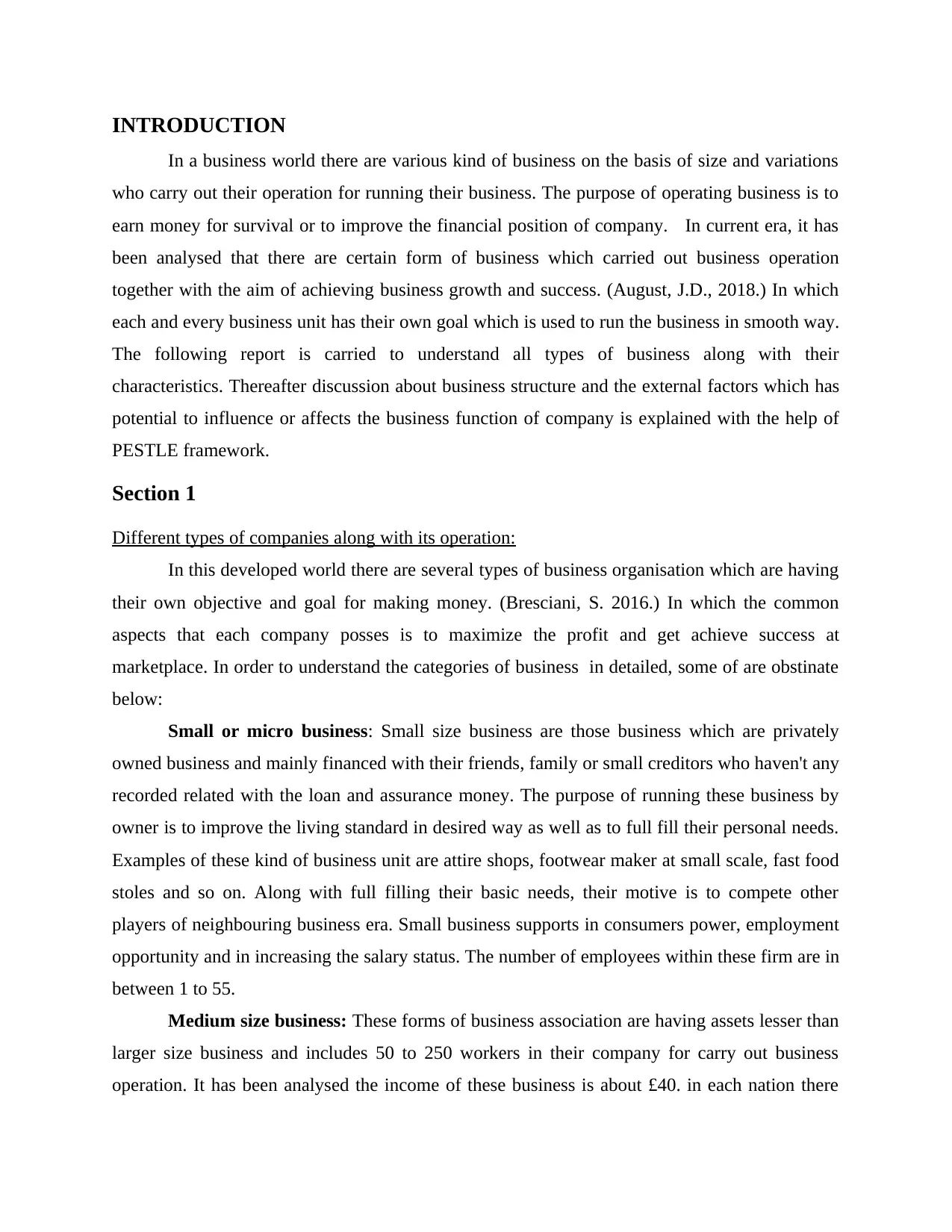
INTRODUCTION
In a business world there are various kind of business on the basis of size and variations
who carry out their operation for running their business. The purpose of operating business is to
earn money for survival or to improve the financial position of company. In current era, it has
been analysed that there are certain form of business which carried out business operation
together with the aim of achieving business growth and success. (August, J.D., 2018.) In which
each and every business unit has their own goal which is used to run the business in smooth way.
The following report is carried to understand all types of business along with their
characteristics. Thereafter discussion about business structure and the external factors which has
potential to influence or affects the business function of company is explained with the help of
PESTLE framework.
Section 1
Different types of companies along with its operation:
In this developed world there are several types of business organisation which are having
their own objective and goal for making money. (Bresciani, S. 2016.) In which the common
aspects that each company posses is to maximize the profit and get achieve success at
marketplace. In order to understand the categories of business in detailed, some of are obstinate
below:
Small or micro business: Small size business are those business which are privately
owned business and mainly financed with their friends, family or small creditors who haven't any
recorded related with the loan and assurance money. The purpose of running these business by
owner is to improve the living standard in desired way as well as to full fill their personal needs.
Examples of these kind of business unit are attire shops, footwear maker at small scale, fast food
stoles and so on. Along with full filling their basic needs, their motive is to compete other
players of neighbouring business era. Small business supports in consumers power, employment
opportunity and in increasing the salary status. The number of employees within these firm are in
between 1 to 55.
Medium size business: These forms of business association are having assets lesser than
larger size business and includes 50 to 250 workers in their company for carry out business
operation. It has been analysed the income of these business is about £40. in each nation there
In a business world there are various kind of business on the basis of size and variations
who carry out their operation for running their business. The purpose of operating business is to
earn money for survival or to improve the financial position of company. In current era, it has
been analysed that there are certain form of business which carried out business operation
together with the aim of achieving business growth and success. (August, J.D., 2018.) In which
each and every business unit has their own goal which is used to run the business in smooth way.
The following report is carried to understand all types of business along with their
characteristics. Thereafter discussion about business structure and the external factors which has
potential to influence or affects the business function of company is explained with the help of
PESTLE framework.
Section 1
Different types of companies along with its operation:
In this developed world there are several types of business organisation which are having
their own objective and goal for making money. (Bresciani, S. 2016.) In which the common
aspects that each company posses is to maximize the profit and get achieve success at
marketplace. In order to understand the categories of business in detailed, some of are obstinate
below:
Small or micro business: Small size business are those business which are privately
owned business and mainly financed with their friends, family or small creditors who haven't any
recorded related with the loan and assurance money. The purpose of running these business by
owner is to improve the living standard in desired way as well as to full fill their personal needs.
Examples of these kind of business unit are attire shops, footwear maker at small scale, fast food
stoles and so on. Along with full filling their basic needs, their motive is to compete other
players of neighbouring business era. Small business supports in consumers power, employment
opportunity and in increasing the salary status. The number of employees within these firm are in
between 1 to 55.
Medium size business: These forms of business association are having assets lesser than
larger size business and includes 50 to 250 workers in their company for carry out business
operation. It has been analysed the income of these business is about £40. in each nation there
⊘ This is a preview!⊘
Do you want full access?
Subscribe today to unlock all pages.

Trusted by 1+ million students worldwide
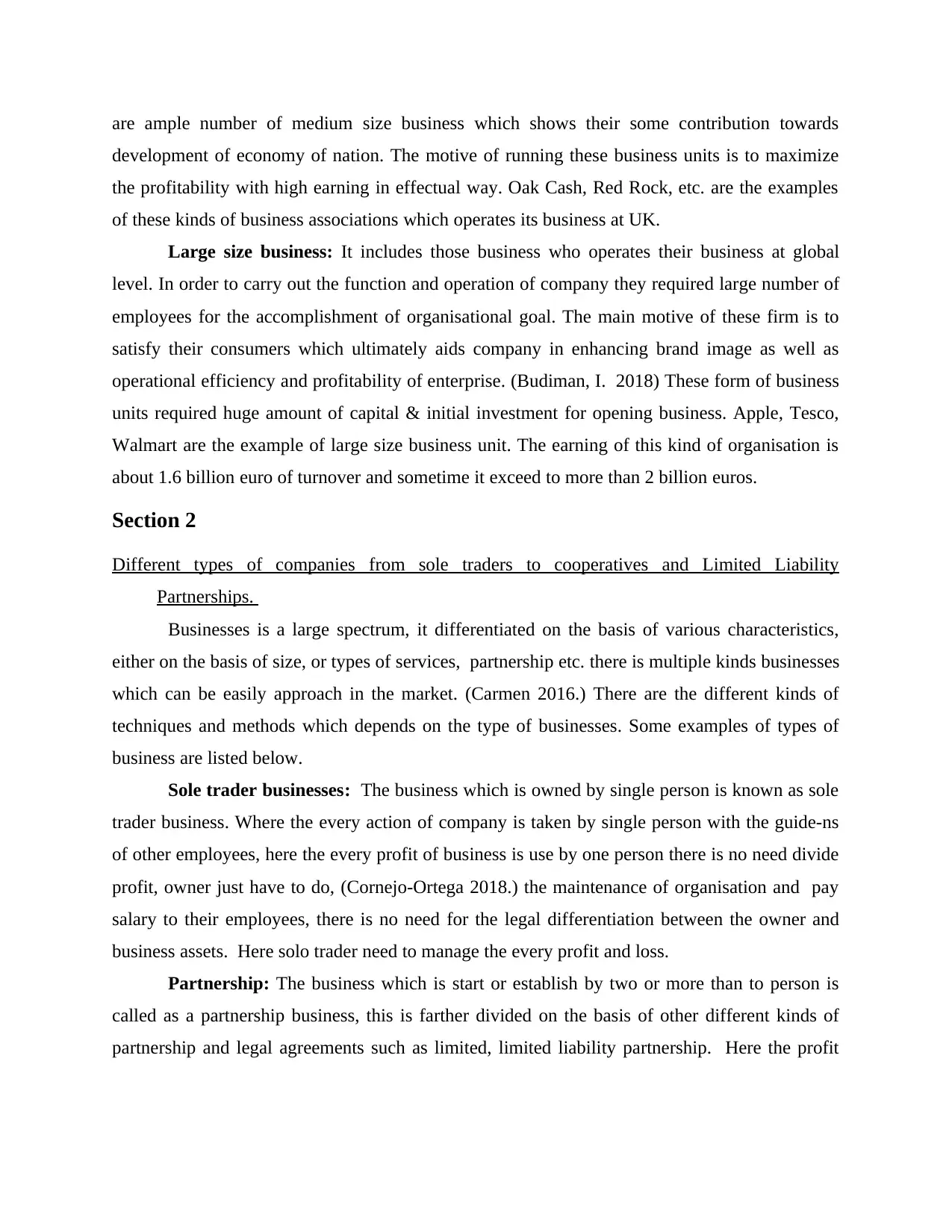
are ample number of medium size business which shows their some contribution towards
development of economy of nation. The motive of running these business units is to maximize
the profitability with high earning in effectual way. Oak Cash, Red Rock, etc. are the examples
of these kinds of business associations which operates its business at UK.
Large size business: It includes those business who operates their business at global
level. In order to carry out the function and operation of company they required large number of
employees for the accomplishment of organisational goal. The main motive of these firm is to
satisfy their consumers which ultimately aids company in enhancing brand image as well as
operational efficiency and profitability of enterprise. (Budiman, I. 2018) These form of business
units required huge amount of capital & initial investment for opening business. Apple, Tesco,
Walmart are the example of large size business unit. The earning of this kind of organisation is
about 1.6 billion euro of turnover and sometime it exceed to more than 2 billion euros.
Section 2
Different types of companies from sole traders to cooperatives and Limited Liability
Partnerships.
Businesses is a large spectrum, it differentiated on the basis of various characteristics,
either on the basis of size, or types of services, partnership etc. there is multiple kinds businesses
which can be easily approach in the market. (Carmen 2016.) There are the different kinds of
techniques and methods which depends on the type of businesses. Some examples of types of
business are listed below.
Sole trader businesses: The business which is owned by single person is known as sole
trader business. Where the every action of company is taken by single person with the guide-ns
of other employees, here the every profit of business is use by one person there is no need divide
profit, owner just have to do, (Cornejo-Ortega 2018.) the maintenance of organisation and pay
salary to their employees, there is no need for the legal differentiation between the owner and
business assets. Here solo trader need to manage the every profit and loss.
Partnership: The business which is start or establish by two or more than to person is
called as a partnership business, this is farther divided on the basis of other different kinds of
partnership and legal agreements such as limited, limited liability partnership. Here the profit
development of economy of nation. The motive of running these business units is to maximize
the profitability with high earning in effectual way. Oak Cash, Red Rock, etc. are the examples
of these kinds of business associations which operates its business at UK.
Large size business: It includes those business who operates their business at global
level. In order to carry out the function and operation of company they required large number of
employees for the accomplishment of organisational goal. The main motive of these firm is to
satisfy their consumers which ultimately aids company in enhancing brand image as well as
operational efficiency and profitability of enterprise. (Budiman, I. 2018) These form of business
units required huge amount of capital & initial investment for opening business. Apple, Tesco,
Walmart are the example of large size business unit. The earning of this kind of organisation is
about 1.6 billion euro of turnover and sometime it exceed to more than 2 billion euros.
Section 2
Different types of companies from sole traders to cooperatives and Limited Liability
Partnerships.
Businesses is a large spectrum, it differentiated on the basis of various characteristics,
either on the basis of size, or types of services, partnership etc. there is multiple kinds businesses
which can be easily approach in the market. (Carmen 2016.) There are the different kinds of
techniques and methods which depends on the type of businesses. Some examples of types of
business are listed below.
Sole trader businesses: The business which is owned by single person is known as sole
trader business. Where the every action of company is taken by single person with the guide-ns
of other employees, here the every profit of business is use by one person there is no need divide
profit, owner just have to do, (Cornejo-Ortega 2018.) the maintenance of organisation and pay
salary to their employees, there is no need for the legal differentiation between the owner and
business assets. Here solo trader need to manage the every profit and loss.
Partnership: The business which is start or establish by two or more than to person is
called as a partnership business, this is farther divided on the basis of other different kinds of
partnership and legal agreements such as limited, limited liability partnership. Here the profit
Paraphrase This Document
Need a fresh take? Get an instant paraphrase of this document with our AI Paraphraser
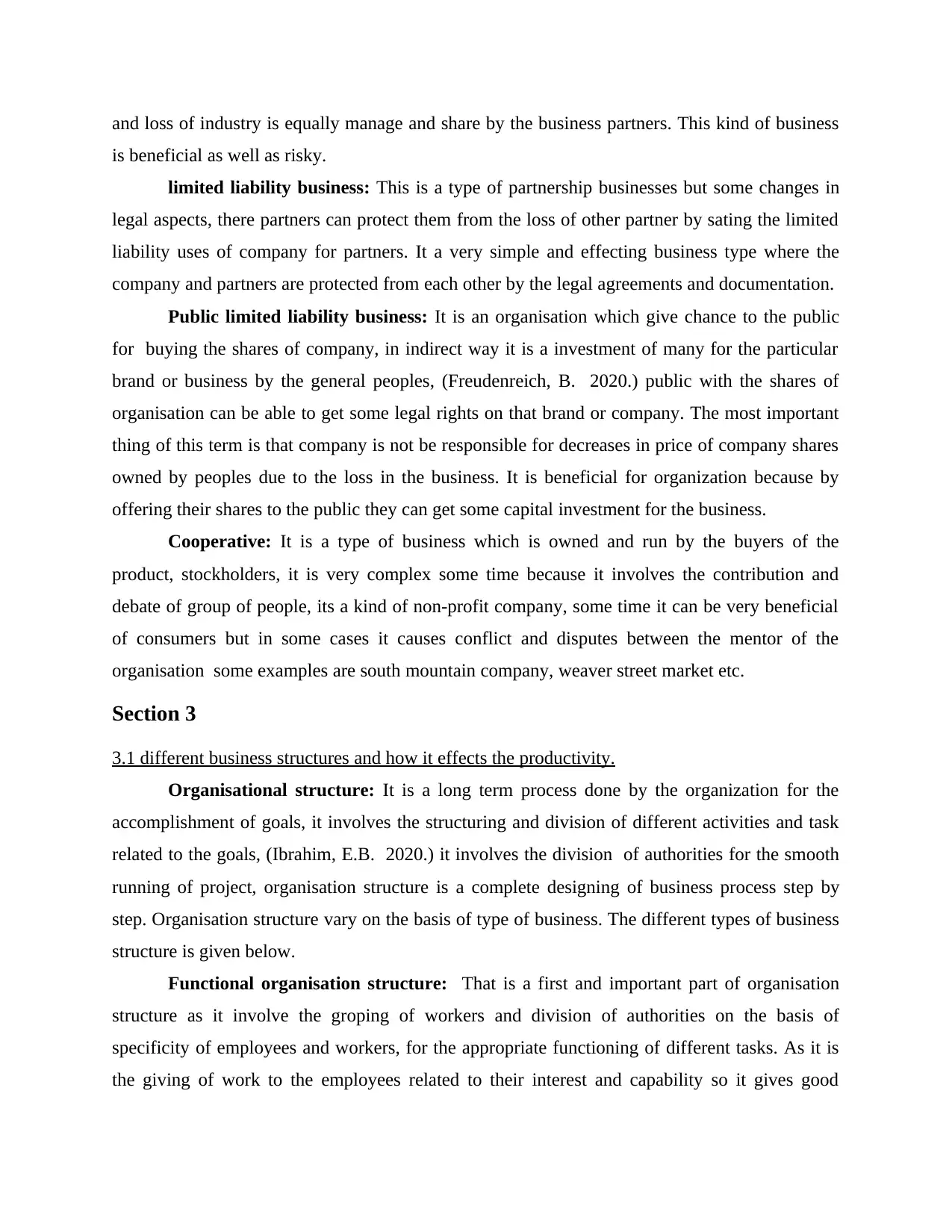
and loss of industry is equally manage and share by the business partners. This kind of business
is beneficial as well as risky.
limited liability business: This is a type of partnership businesses but some changes in
legal aspects, there partners can protect them from the loss of other partner by sating the limited
liability uses of company for partners. It a very simple and effecting business type where the
company and partners are protected from each other by the legal agreements and documentation.
Public limited liability business: It is an organisation which give chance to the public
for buying the shares of company, in indirect way it is a investment of many for the particular
brand or business by the general peoples, (Freudenreich, B. 2020.) public with the shares of
organisation can be able to get some legal rights on that brand or company. The most important
thing of this term is that company is not be responsible for decreases in price of company shares
owned by peoples due to the loss in the business. It is beneficial for organization because by
offering their shares to the public they can get some capital investment for the business.
Cooperative: It is a type of business which is owned and run by the buyers of the
product, stockholders, it is very complex some time because it involves the contribution and
debate of group of people, its a kind of non-profit company, some time it can be very beneficial
of consumers but in some cases it causes conflict and disputes between the mentor of the
organisation some examples are south mountain company, weaver street market etc.
Section 3
3.1 different business structures and how it effects the productivity.
Organisational structure: It is a long term process done by the organization for the
accomplishment of goals, it involves the structuring and division of different activities and task
related to the goals, (Ibrahim, E.B. 2020.) it involves the division of authorities for the smooth
running of project, organisation structure is a complete designing of business process step by
step. Organisation structure vary on the basis of type of business. The different types of business
structure is given below.
Functional organisation structure: That is a first and important part of organisation
structure as it involve the groping of workers and division of authorities on the basis of
specificity of employees and workers, for the appropriate functioning of different tasks. As it is
the giving of work to the employees related to their interest and capability so it gives good
is beneficial as well as risky.
limited liability business: This is a type of partnership businesses but some changes in
legal aspects, there partners can protect them from the loss of other partner by sating the limited
liability uses of company for partners. It a very simple and effecting business type where the
company and partners are protected from each other by the legal agreements and documentation.
Public limited liability business: It is an organisation which give chance to the public
for buying the shares of company, in indirect way it is a investment of many for the particular
brand or business by the general peoples, (Freudenreich, B. 2020.) public with the shares of
organisation can be able to get some legal rights on that brand or company. The most important
thing of this term is that company is not be responsible for decreases in price of company shares
owned by peoples due to the loss in the business. It is beneficial for organization because by
offering their shares to the public they can get some capital investment for the business.
Cooperative: It is a type of business which is owned and run by the buyers of the
product, stockholders, it is very complex some time because it involves the contribution and
debate of group of people, its a kind of non-profit company, some time it can be very beneficial
of consumers but in some cases it causes conflict and disputes between the mentor of the
organisation some examples are south mountain company, weaver street market etc.
Section 3
3.1 different business structures and how it effects the productivity.
Organisational structure: It is a long term process done by the organization for the
accomplishment of goals, it involves the structuring and division of different activities and task
related to the goals, (Ibrahim, E.B. 2020.) it involves the division of authorities for the smooth
running of project, organisation structure is a complete designing of business process step by
step. Organisation structure vary on the basis of type of business. The different types of business
structure is given below.
Functional organisation structure: That is a first and important part of organisation
structure as it involve the groping of workers and division of authorities on the basis of
specificity of employees and workers, for the appropriate functioning of different tasks. As it is
the giving of work to the employees related to their interest and capability so it gives good
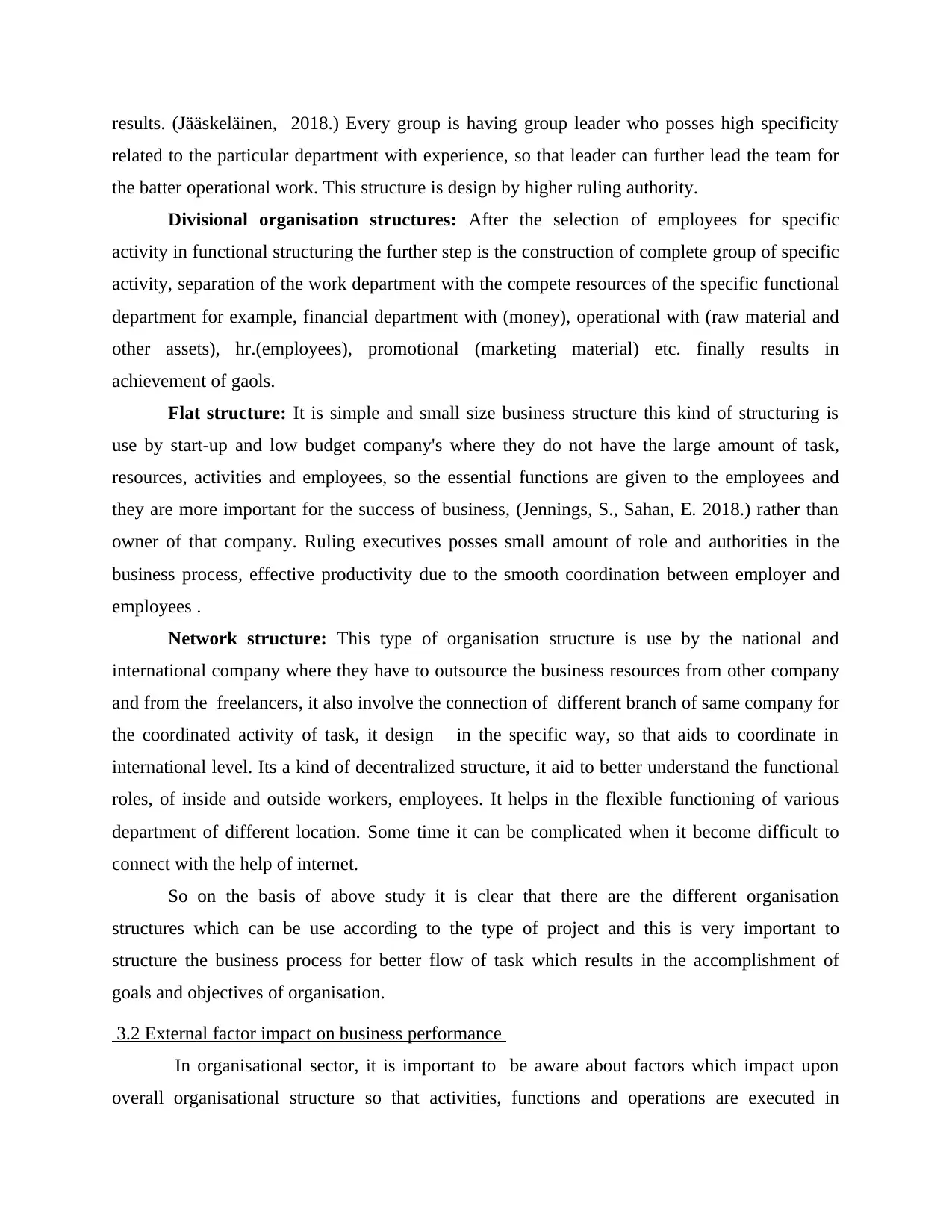
results. (Jääskeläinen, 2018.) Every group is having group leader who posses high specificity
related to the particular department with experience, so that leader can further lead the team for
the batter operational work. This structure is design by higher ruling authority.
Divisional organisation structures: After the selection of employees for specific
activity in functional structuring the further step is the construction of complete group of specific
activity, separation of the work department with the compete resources of the specific functional
department for example, financial department with (money), operational with (raw material and
other assets), hr.(employees), promotional (marketing material) etc. finally results in
achievement of gaols.
Flat structure: It is simple and small size business structure this kind of structuring is
use by start-up and low budget company's where they do not have the large amount of task,
resources, activities and employees, so the essential functions are given to the employees and
they are more important for the success of business, (Jennings, S., Sahan, E. 2018.) rather than
owner of that company. Ruling executives posses small amount of role and authorities in the
business process, effective productivity due to the smooth coordination between employer and
employees .
Network structure: This type of organisation structure is use by the national and
international company where they have to outsource the business resources from other company
and from the freelancers, it also involve the connection of different branch of same company for
the coordinated activity of task, it design in the specific way, so that aids to coordinate in
international level. Its a kind of decentralized structure, it aid to better understand the functional
roles, of inside and outside workers, employees. It helps in the flexible functioning of various
department of different location. Some time it can be complicated when it become difficult to
connect with the help of internet.
So on the basis of above study it is clear that there are the different organisation
structures which can be use according to the type of project and this is very important to
structure the business process for better flow of task which results in the accomplishment of
goals and objectives of organisation.
3.2 External factor impact on business performance
In organisational sector, it is important to be aware about factors which impact upon
overall organisational structure so that activities, functions and operations are executed in
related to the particular department with experience, so that leader can further lead the team for
the batter operational work. This structure is design by higher ruling authority.
Divisional organisation structures: After the selection of employees for specific
activity in functional structuring the further step is the construction of complete group of specific
activity, separation of the work department with the compete resources of the specific functional
department for example, financial department with (money), operational with (raw material and
other assets), hr.(employees), promotional (marketing material) etc. finally results in
achievement of gaols.
Flat structure: It is simple and small size business structure this kind of structuring is
use by start-up and low budget company's where they do not have the large amount of task,
resources, activities and employees, so the essential functions are given to the employees and
they are more important for the success of business, (Jennings, S., Sahan, E. 2018.) rather than
owner of that company. Ruling executives posses small amount of role and authorities in the
business process, effective productivity due to the smooth coordination between employer and
employees .
Network structure: This type of organisation structure is use by the national and
international company where they have to outsource the business resources from other company
and from the freelancers, it also involve the connection of different branch of same company for
the coordinated activity of task, it design in the specific way, so that aids to coordinate in
international level. Its a kind of decentralized structure, it aid to better understand the functional
roles, of inside and outside workers, employees. It helps in the flexible functioning of various
department of different location. Some time it can be complicated when it become difficult to
connect with the help of internet.
So on the basis of above study it is clear that there are the different organisation
structures which can be use according to the type of project and this is very important to
structure the business process for better flow of task which results in the accomplishment of
goals and objectives of organisation.
3.2 External factor impact on business performance
In organisational sector, it is important to be aware about factors which impact upon
overall organisational structure so that activities, functions and operations are executed in
⊘ This is a preview!⊘
Do you want full access?
Subscribe today to unlock all pages.

Trusted by 1+ million students worldwide
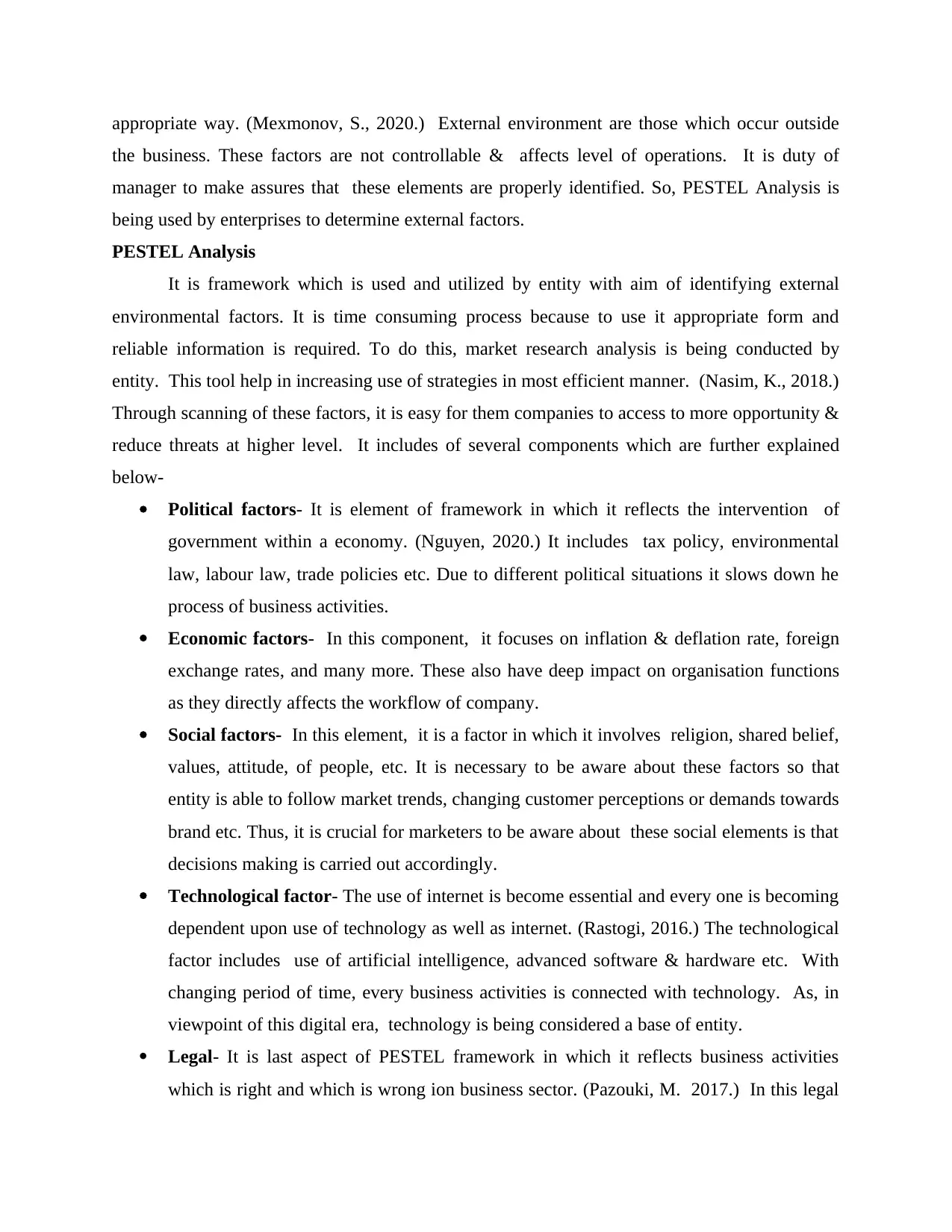
appropriate way. (Mexmonov, S., 2020.) External environment are those which occur outside
the business. These factors are not controllable & affects level of operations. It is duty of
manager to make assures that these elements are properly identified. So, PESTEL Analysis is
being used by enterprises to determine external factors.
PESTEL Analysis
It is framework which is used and utilized by entity with aim of identifying external
environmental factors. It is time consuming process because to use it appropriate form and
reliable information is required. To do this, market research analysis is being conducted by
entity. This tool help in increasing use of strategies in most efficient manner. (Nasim, K., 2018.)
Through scanning of these factors, it is easy for them companies to access to more opportunity &
reduce threats at higher level. It includes of several components which are further explained
below-
Political factors- It is element of framework in which it reflects the intervention of
government within a economy. (Nguyen, 2020.) It includes tax policy, environmental
law, labour law, trade policies etc. Due to different political situations it slows down he
process of business activities.
Economic factors- In this component, it focuses on inflation & deflation rate, foreign
exchange rates, and many more. These also have deep impact on organisation functions
as they directly affects the workflow of company.
Social factors- In this element, it is a factor in which it involves religion, shared belief,
values, attitude, of people, etc. It is necessary to be aware about these factors so that
entity is able to follow market trends, changing customer perceptions or demands towards
brand etc. Thus, it is crucial for marketers to be aware about these social elements is that
decisions making is carried out accordingly.
Technological factor- The use of internet is become essential and every one is becoming
dependent upon use of technology as well as internet. (Rastogi, 2016.) The technological
factor includes use of artificial intelligence, advanced software & hardware etc. With
changing period of time, every business activities is connected with technology. As, in
viewpoint of this digital era, technology is being considered a base of entity.
Legal- It is last aspect of PESTEL framework in which it reflects business activities
which is right and which is wrong ion business sector. (Pazouki, M. 2017.) In this legal
the business. These factors are not controllable & affects level of operations. It is duty of
manager to make assures that these elements are properly identified. So, PESTEL Analysis is
being used by enterprises to determine external factors.
PESTEL Analysis
It is framework which is used and utilized by entity with aim of identifying external
environmental factors. It is time consuming process because to use it appropriate form and
reliable information is required. To do this, market research analysis is being conducted by
entity. This tool help in increasing use of strategies in most efficient manner. (Nasim, K., 2018.)
Through scanning of these factors, it is easy for them companies to access to more opportunity &
reduce threats at higher level. It includes of several components which are further explained
below-
Political factors- It is element of framework in which it reflects the intervention of
government within a economy. (Nguyen, 2020.) It includes tax policy, environmental
law, labour law, trade policies etc. Due to different political situations it slows down he
process of business activities.
Economic factors- In this component, it focuses on inflation & deflation rate, foreign
exchange rates, and many more. These also have deep impact on organisation functions
as they directly affects the workflow of company.
Social factors- In this element, it is a factor in which it involves religion, shared belief,
values, attitude, of people, etc. It is necessary to be aware about these factors so that
entity is able to follow market trends, changing customer perceptions or demands towards
brand etc. Thus, it is crucial for marketers to be aware about these social elements is that
decisions making is carried out accordingly.
Technological factor- The use of internet is become essential and every one is becoming
dependent upon use of technology as well as internet. (Rastogi, 2016.) The technological
factor includes use of artificial intelligence, advanced software & hardware etc. With
changing period of time, every business activities is connected with technology. As, in
viewpoint of this digital era, technology is being considered a base of entity.
Legal- It is last aspect of PESTEL framework in which it reflects business activities
which is right and which is wrong ion business sector. (Pazouki, M. 2017.) In this legal
Paraphrase This Document
Need a fresh take? Get an instant paraphrase of this document with our AI Paraphraser
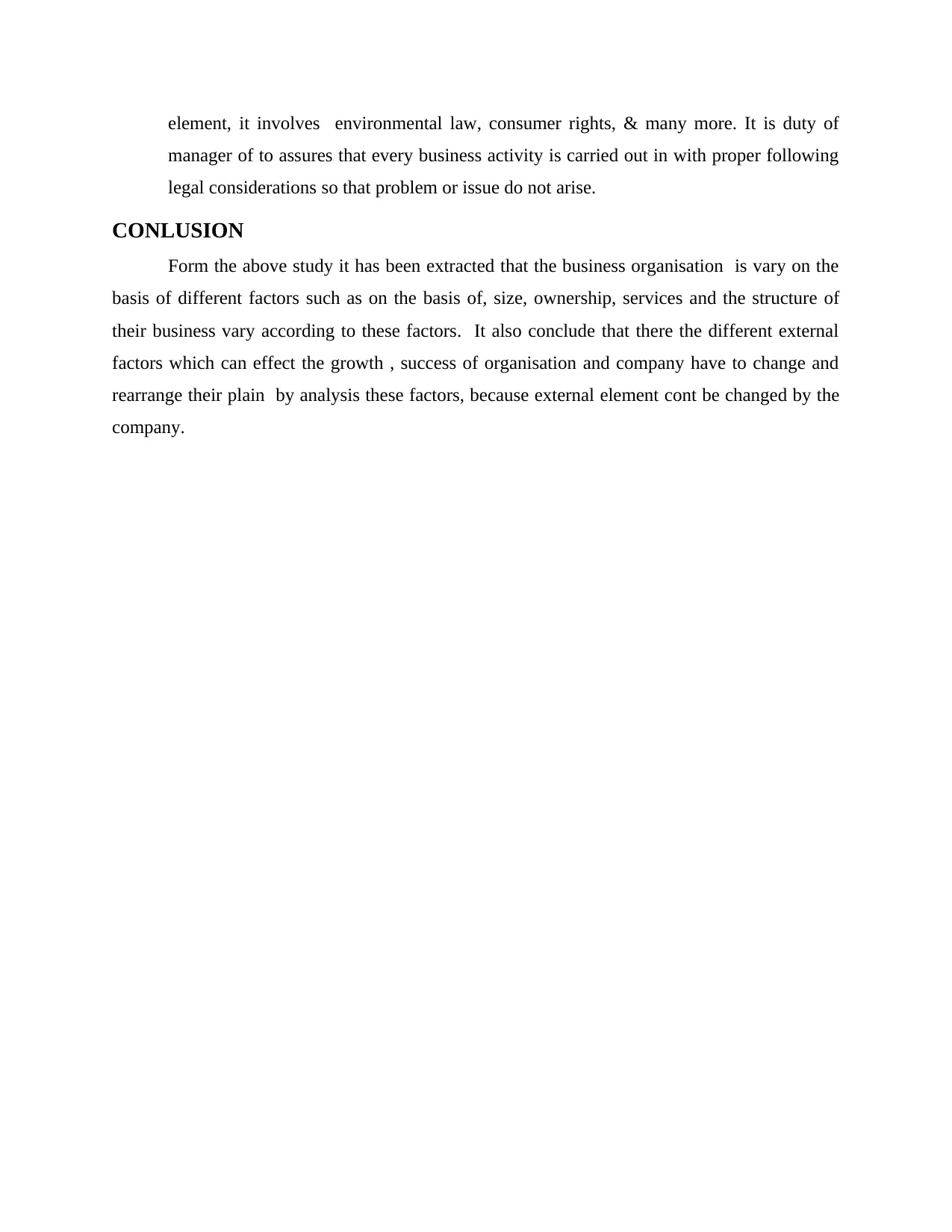
element, it involves environmental law, consumer rights, & many more. It is duty of
manager of to assures that every business activity is carried out in with proper following
legal considerations so that problem or issue do not arise.
CONLUSION
Form the above study it has been extracted that the business organisation is vary on the
basis of different factors such as on the basis of, size, ownership, services and the structure of
their business vary according to these factors. It also conclude that there the different external
factors which can effect the growth , success of organisation and company have to change and
rearrange their plain by analysis these factors, because external element cont be changed by the
company.
manager of to assures that every business activity is carried out in with proper following
legal considerations so that problem or issue do not arise.
CONLUSION
Form the above study it has been extracted that the business organisation is vary on the
basis of different factors such as on the basis of, size, ownership, services and the structure of
their business vary according to these factors. It also conclude that there the different external
factors which can effect the growth , success of organisation and company have to change and
rearrange their plain by analysis these factors, because external element cont be changed by the
company.
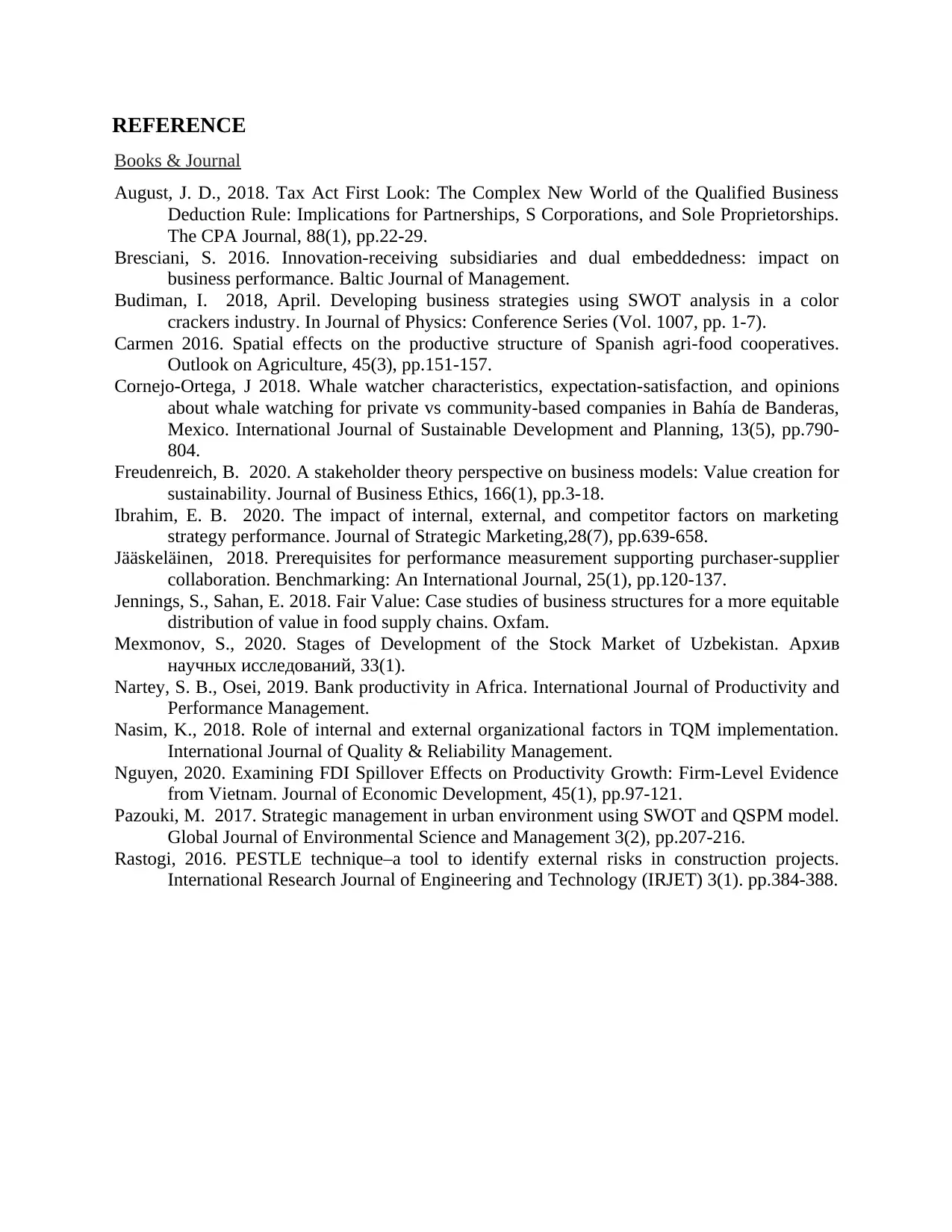
REFERENCE
Books & Journal
August, J. D., 2018. Tax Act First Look: The Complex New World of the Qualified Business
Deduction Rule: Implications for Partnerships, S Corporations, and Sole Proprietorships.
The CPA Journal, 88(1), pp.22-29.
Bresciani, S. 2016. Innovation-receiving subsidiaries and dual embeddedness: impact on
business performance. Baltic Journal of Management.
Budiman, I. 2018, April. Developing business strategies using SWOT analysis in a color
crackers industry. In Journal of Physics: Conference Series (Vol. 1007, pp. 1-7).
Carmen 2016. Spatial effects on the productive structure of Spanish agri-food cooperatives.
Outlook on Agriculture, 45(3), pp.151-157.
Cornejo-Ortega, J 2018. Whale watcher characteristics, expectation-satisfaction, and opinions
about whale watching for private vs community-based companies in Bahía de Banderas,
Mexico. International Journal of Sustainable Development and Planning, 13(5), pp.790-
804.
Freudenreich, B. 2020. A stakeholder theory perspective on business models: Value creation for
sustainability. Journal of Business Ethics, 166(1), pp.3-18.
Ibrahim, E. B. 2020. The impact of internal, external, and competitor factors on marketing
strategy performance. Journal of Strategic Marketing,28(7), pp.639-658.
Jääskeläinen, 2018. Prerequisites for performance measurement supporting purchaser-supplier
collaboration. Benchmarking: An International Journal, 25(1), pp.120-137.
Jennings, S., Sahan, E. 2018. Fair Value: Case studies of business structures for a more equitable
distribution of value in food supply chains. Oxfam.
Mexmonov, S., 2020. Stages of Development of the Stock Market of Uzbekistan. Архив
научных исследований, 33(1).
Nartey, S. B., Osei, 2019. Bank productivity in Africa. International Journal of Productivity and
Performance Management.
Nasim, K., 2018. Role of internal and external organizational factors in TQM implementation.
International Journal of Quality & Reliability Management.
Nguyen, 2020. Examining FDI Spillover Effects on Productivity Growth: Firm-Level Evidence
from Vietnam. Journal of Economic Development, 45(1), pp.97-121.
Pazouki, M. 2017. Strategic management in urban environment using SWOT and QSPM model.
Global Journal of Environmental Science and Management 3(2), pp.207-216.
Rastogi, 2016. PESTLE technique–a tool to identify external risks in construction projects.
International Research Journal of Engineering and Technology (IRJET) 3(1). pp.384-388.
Books & Journal
August, J. D., 2018. Tax Act First Look: The Complex New World of the Qualified Business
Deduction Rule: Implications for Partnerships, S Corporations, and Sole Proprietorships.
The CPA Journal, 88(1), pp.22-29.
Bresciani, S. 2016. Innovation-receiving subsidiaries and dual embeddedness: impact on
business performance. Baltic Journal of Management.
Budiman, I. 2018, April. Developing business strategies using SWOT analysis in a color
crackers industry. In Journal of Physics: Conference Series (Vol. 1007, pp. 1-7).
Carmen 2016. Spatial effects on the productive structure of Spanish agri-food cooperatives.
Outlook on Agriculture, 45(3), pp.151-157.
Cornejo-Ortega, J 2018. Whale watcher characteristics, expectation-satisfaction, and opinions
about whale watching for private vs community-based companies in Bahía de Banderas,
Mexico. International Journal of Sustainable Development and Planning, 13(5), pp.790-
804.
Freudenreich, B. 2020. A stakeholder theory perspective on business models: Value creation for
sustainability. Journal of Business Ethics, 166(1), pp.3-18.
Ibrahim, E. B. 2020. The impact of internal, external, and competitor factors on marketing
strategy performance. Journal of Strategic Marketing,28(7), pp.639-658.
Jääskeläinen, 2018. Prerequisites for performance measurement supporting purchaser-supplier
collaboration. Benchmarking: An International Journal, 25(1), pp.120-137.
Jennings, S., Sahan, E. 2018. Fair Value: Case studies of business structures for a more equitable
distribution of value in food supply chains. Oxfam.
Mexmonov, S., 2020. Stages of Development of the Stock Market of Uzbekistan. Архив
научных исследований, 33(1).
Nartey, S. B., Osei, 2019. Bank productivity in Africa. International Journal of Productivity and
Performance Management.
Nasim, K., 2018. Role of internal and external organizational factors in TQM implementation.
International Journal of Quality & Reliability Management.
Nguyen, 2020. Examining FDI Spillover Effects on Productivity Growth: Firm-Level Evidence
from Vietnam. Journal of Economic Development, 45(1), pp.97-121.
Pazouki, M. 2017. Strategic management in urban environment using SWOT and QSPM model.
Global Journal of Environmental Science and Management 3(2), pp.207-216.
Rastogi, 2016. PESTLE technique–a tool to identify external risks in construction projects.
International Research Journal of Engineering and Technology (IRJET) 3(1). pp.384-388.
⊘ This is a preview!⊘
Do you want full access?
Subscribe today to unlock all pages.

Trusted by 1+ million students worldwide
1 out of 9
Related Documents
Your All-in-One AI-Powered Toolkit for Academic Success.
+13062052269
info@desklib.com
Available 24*7 on WhatsApp / Email
![[object Object]](/_next/static/media/star-bottom.7253800d.svg)
Unlock your academic potential
Copyright © 2020–2025 A2Z Services. All Rights Reserved. Developed and managed by ZUCOL.





